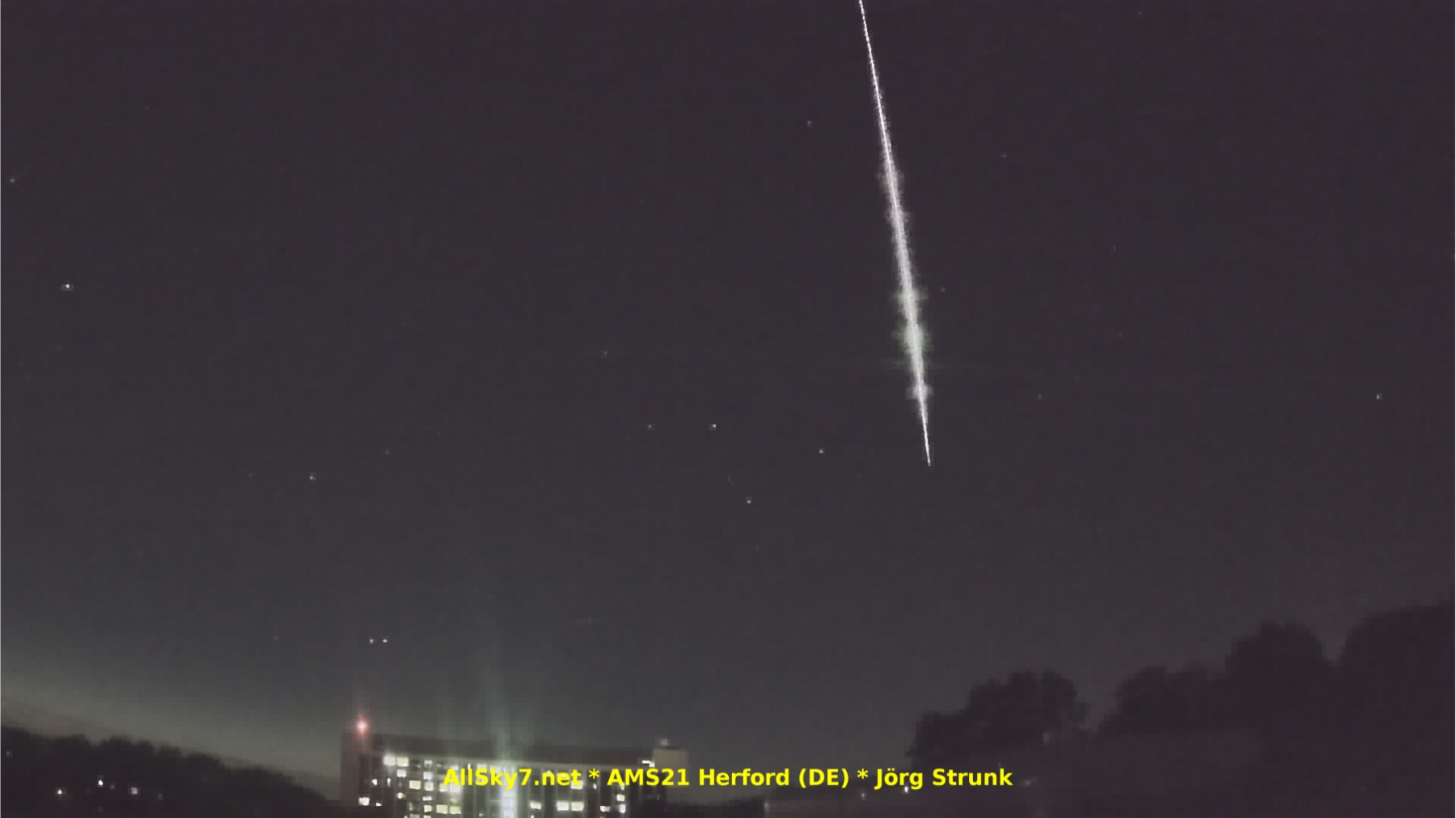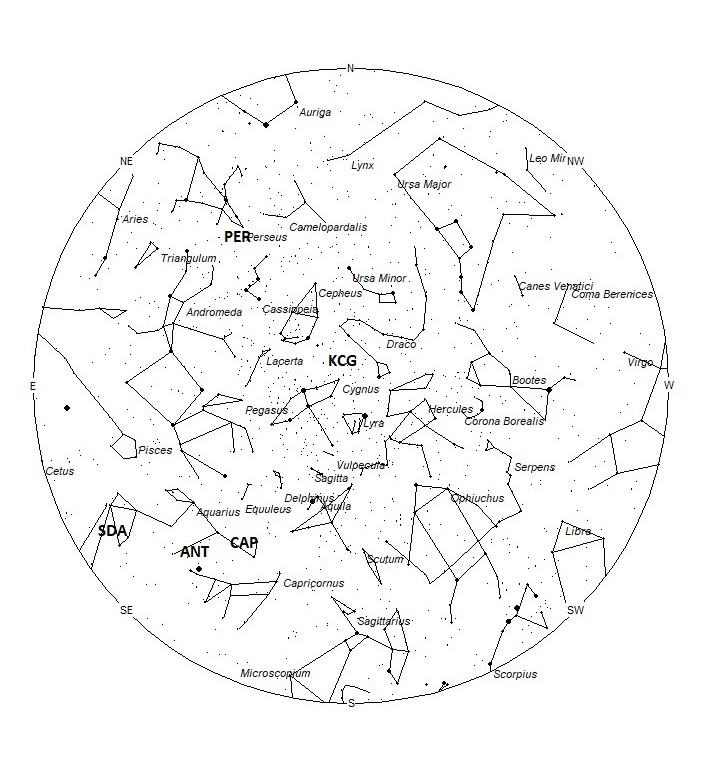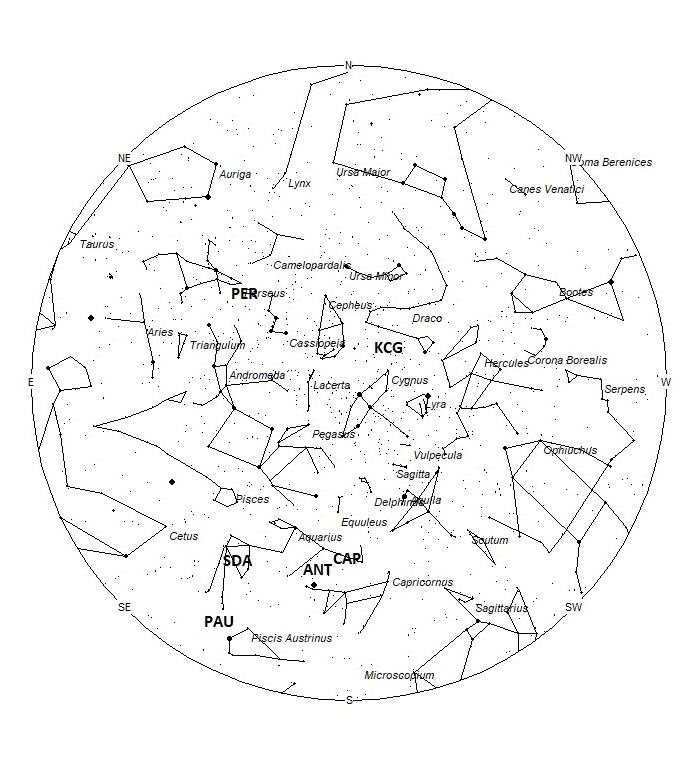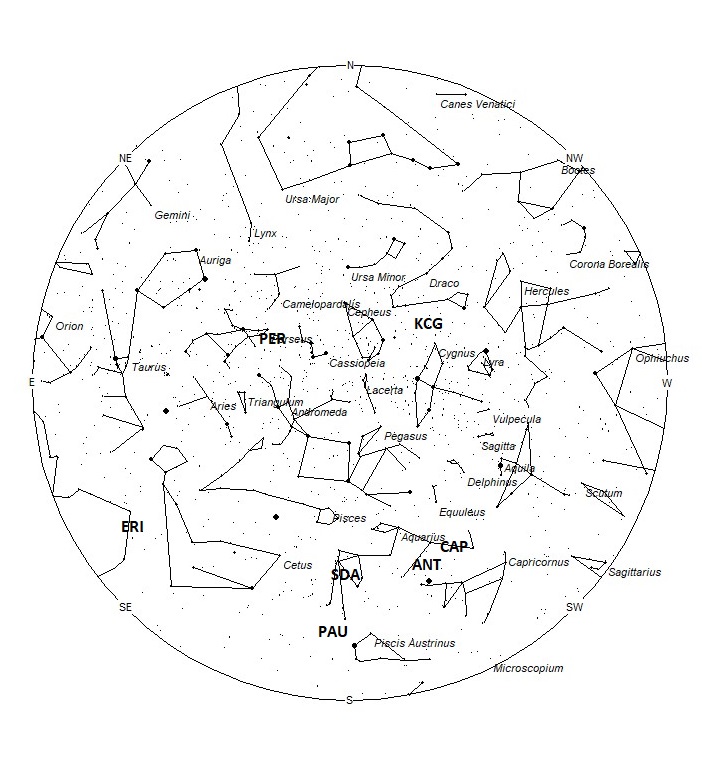 Jörg Strunk captured this fireball with his AllSky7 Camera System at 20:50 UT (22:50 CEST) on May 8, 2022, from Herford, Germany. For more information on this fireball visit: https://fireball.imo.net/members/imo_view/event/2022/2329 ©Jörg Strunk
Jörg Strunk captured this fireball with his AllSky7 Camera System at 20:50 UT (22:50 CEST) on May 8, 2022, from Herford, Germany. For more information on this fireball visit: https://fireball.imo.net/members/imo_view/event/2022/2329 ©Jörg StrunkDuring this period, the moon reaches its full phase on Friday August 12th. At that time the moon is located opposite the sun and will lie above the horizon all night long. This weekend the waxing gibbous moon will set during the early morning hours allowing a couple of hours to view meteor activity prior to dawn. The estimated total hourly rates for evening observers this week should be near 3 as seen from mid-northern latitudes (45N) and 3 as seen from tropical southern locations (25S) For morning observers, the estimated total hourly rates should be near 30 as seen from mid-northern latitudes (45N) and 22 as seen from tropical southern locations (25S). The actual rates will also depend on factors such as personal light and motion perception, local weather conditions, alertness, and experience in watching meteor activity. Evening rates are reduced due to moonlight. Note that the hourly rates listed below are estimates as viewed from dark sky sites away from urban light sources. Observers viewing from urban areas will see less activity as only the brighter meteors will be visible from such locations.
The radiant (the area of the sky where meteors appear to shoot from) positions and rates listed below are exact for Saturday night/Sunday morning August 6/7. These positions do not change greatly day to day so the listed coordinates may be used during this entire period. Most star atlases (available at science stores and planetariums) will provide maps with grid lines of the celestial coordinates so that you may find out exactly where these positions are located in the sky. I have also included charts of the sky that display the radiant positions for evening, midnight, and morning. The center of each chart is the sky directly overhead at the appropriate hour. These charts are oriented for facing south but can be used for any direction by rotating the charts to the desired direction. A planisphere or computer planetarium program is also useful in showing the sky at any time of night on any date of the year. Activity from each radiant is best seen when it is positioned highest in the sky, either due north or south along the meridian, depending on your latitude. It must be remembered that meteor activity is rarely seen at the radiant position. Rather they shoot outwards from the radiant, so it is best to center your field of view so that the radiant lies at the edge and not the center. Viewing there will allow you to easily trace the path of each meteor back to the radiant (if it is a shower member) or in another direction if it is sporadic. Meteor activity is not seen from radiants that are located far below the horizon. The positions below are listed in a west to east manner in order of right ascension (celestial longitude). The positions listed first are located further west therefore are accessible earlier in the night while those listed further down the list rise later in the night.
These sources of meteoric activity are expected to be active this week.
.
The kappa Cygnids (KCG) are active from August 1-27, with maximum occurring on the 14th. The radiant is currently located at 18:52 (283) +58. This area of the sky is located in southern Draco, 6 degrees northwest of the 4th magnitude star known as kappa Cygni. To best see these meteors face low toward the north near 2300 LST when it lies on the meridian and is located highest in the sky. With a high northern declination, these meteors are difficult to view from the southern hemisphere. Expected hourly rates this week are less than 1 no matter your location. With an entry velocity of 25 km/sec., the average meteor from this source would be of slow velocity.
The alpha Capricornids (CAP) are active from July 7 through August 15, peaking on July 31st. The radiant is currently located at 21:00 (315) -07 This position lies in northwestern Aquarius, 3 degrees southeast of the 4th magnitude star known as 3 Aquarii. Current rates are expected to be near 1 per hour as seen from the Northern Hemisphere and 2 per hour as seen from south of the equator. Observers concentrating on this activity should face high in the northern sky near midnight (LST) to best view these meteors. With an entry velocity of 23 km/sec., the average meteor from this source would be of slow velocity.
The large Anthelion (ANT) radiant is currently centered at 21:48 (327) -11. This position lies in northeastern Capricornus, 5 degrees north of the 4th magnitude star known as Deneb Algedi (delta Capricorni A). This position is also 4 degrees northeast of the bright planet Saturn. Rates at this time should be near 1 per hour as seen from the Northern Hemisphere and 2 as seen from south of the equator. Observers concentrating on this activity should face high in the northern sky near 01:00 LST to best view these meteors. With an entry velocity of 30 km/sec., the average Anthelion meteor would be of slow velocity.
The Southern delta Aquariids (SDA) are active from a radiant located at 23:08 (347) -14. This area of the sky is located in southwestern Aquarius, 3 degrees northeast of the 3rd magnitude star known as Skat (delta Aquarii). Hourly rates at this time should be near 3 as seen from the Northern Hemisphere and near 5 as seen from south of the equator. Observers concentrating on this activity should face high in the western sky near 02:00 LST to best view these meteors. With an entry velocity of 41 km/sec., the average meteor from this source would be of medium velocity.
The Piscids Austrinids (PAU) are an obscure shower, not well seen from the northern hemisphere. Recent studies by the IMO Video Network shows little activity. Other studies have indicated that this shower is active later than previously thought. The IMO shower calendar states that this radiant is active from July 15th through August 10th, with maximum activity occurring on July 28th. Using these parameters, the current position of the radiant would be 23:20 (350) -27. This area of the sky is located in northwestern Sculptor, 4 degrees northeast of 1st magnitude star known as Fomalhaut (alpha Piscis Austrini). To best see these meteors look high in the southern sky near 03:00 LST, when it lies highest in the sky. Current hourly rates should be less than 1 no matter your location. With an entry velocity of 35km/sec., most activity from this radiant would be of medium velocities.
The Perseids (PER) are active from a radiant located at 02:40 (040) +56. This position lies in northeastern Pereus, 1 degree southwest of the 4th magnitude star known as Miram (eta Persei A). Current rates are expected to be near 10 per hour as seen from the Northern Hemisphere and 3 as seen from southern tropical locations. Observers concentrating on this activity should face half-way up in the northern sky during the last dark hour prior to dawn to best view these meteors. Observers in the northern hemisphere are better situated to view this activity as the radiant rises much higher in the sky before dawn compared to southern latitudes. With an entry velocity of 59 km/sec., the average meteor from this source would be of swift velocity.
The eta Eridanids (ERI) were discovered by the Tokyo Meteor Network back in 2001. The radiant is currently located near 02:44 (041) -13. This position lies on the Cetus/Eridanus border, 1 degree north of the 4th magnitude star known as pi Ceti. This source is active until September 10th, with maximum activity occurring on August 6th. Current rates would be near 1 per hour no matter your location. Observers concentrating on this activity should face high up in the eastern sky during the last dark hour prior to dawn to best view these meteors. With an entry velocity of 64 km/sec., the average meteor from this source would be of swift speed.
As seen from the mid-northern hemisphere (45N) one would expect to see approximately 14 sporadic meteors per hour during the last hour before dawn as seen from rural observing sites. Evening rates would be near 2 per hour. As seen from the tropical southern latitudes (25S), morning rates would be near 9 per hour as seen from rural observing sites and 2 per hour during the evening hours. Locations between these two extremes would see activity between the listed figures. Evening rates are reduced due to moonlight.
The list below offers the information from above in tabular form. Rates and positions are exact for Saturday night/Sunday morning except where noted in the shower descriptions.
| SHOWER | DATE OF MAXIMUM ACTIVITY | CELESTIAL POSITION | ENTRY VELOCITY | CULMINATION | HOURLY RATE | CLASS |
| RA (RA in Deg.) DEC | Km/Sec | Local Summer Time | North-South | |||
| kappa Cygnids (KCG) | Aug 18 | 18:52 (283) +58 | 25 | 23:00 | <1 – <1 | II |
| alpha Capricornids (CAP) | Jul 30 | 21:00 (315) -07 | 23 | 01:00 | 1 – 2 | II |
| Anthelion (ANT) | – | 21:48 (327) -11 | 30 | 02:00 | 1 – 2 | II |
| Southern delta Aquariids (SDA) | Jul 30 | 23:08(347) -14 | 41 | 03:00 | 3 – 5 | I |
| Piscids Austrinids (PAU) | Jul 28 | 23:20 (350) -27 | 35 | 04:00 | <1 – <1 | IV |
| Perseids (PER) | Aug 13 | 02:40 (040) +56 | 59 | 06:00 | 10 – 3 | I |
| eta Eridanids (ERI) | Aug 08 | 02:44 (041) -13 | 64 | 07:00 | 1 – 1 | II |







 You saw something bright and fast? Like a huge shooting star? Report it: it may be a fireball.
You saw something bright and fast? Like a huge shooting star? Report it: it may be a fireball.  You counted meteors last night? Share your results with us!
You counted meteors last night? Share your results with us!  You took a photo of a meteor or fireball? You have a screenshot of your cam? Share it with us!
You took a photo of a meteor or fireball? You have a screenshot of your cam? Share it with us!  You caught a meteor or fireball on video? Share your video with us!
You caught a meteor or fireball on video? Share your video with us!
One comment
I saw a meteor come to earth the size of the moon around 12 o clock about a week ago and it did not burn out until it almost hit the ground. please let me know I of course have not photos but did tell my friend about it across the hall